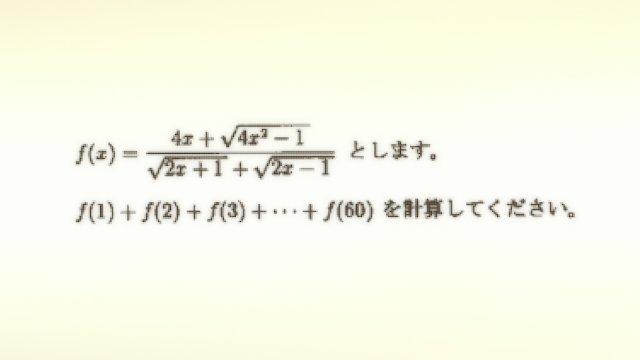The High School Balls
It's been more than half a year since the last post! When some people say video games are dangerous, this is what they mean: they broke my routine and getting back was extremely difficult. On a related update, I'll leave Terry's book posts in hiatus for the time being. I worked out more of them, but writing them all down seems more like a task than anything else at this point. I may eventually go back to them, but for now I'll take a break (implying these months haven't been a one...)
 |
| Portrait of the author as a young girl for a good chunk of this year. |
Do not despair though, dear reader, since that doesn't mean the math content will disappear. In fact, this post will be about math! As I've mentioned in some places here or in Twitter, I'm a high school math teacher. Among the many things we have to do is make problems/questions/exams. Given that I got a $9999+$ in my laziness skill, you would probably expect me to use the common strategy of looking for questions online or in a textbook, but you would be mistaken!
Surprisingly, I enjoy coming up with my own questions; in general ones that depend on more than just a direct application of lesson content. Advantages are various: Being able to decide the difficulty, tailor-make questions that would reveal whether students grasp some concept they were struggling with in class, etc... but, perhaps most importantly, making problems is a surprisingly good way to find little random results and form a basis from which students can take it to wherever they want. This post will be about one such thing.
The Circles
I was recently looking for a multi-step problem for students who haven't done calculus yet, but have a good math basis aside from that (around first year of IB HL for reference). With that in mind, I started playing with circles in different configurations, with the final goal being a general formula for areas or something to that effect. In particular, I thought about letting the center of a series of circles follow some curve, the first ones of course being lines (which turn up quite nicely too), but settled with a parabola. Since I'll be talking about this one more in more detail, let's set the stage a bit more clearly:
Let $C_1$ be a circle of radius $1$ centered at $(1,1)$ in the plane. A series of circles $C_k$ are drawn with the following conditions: The circle must be tangent to the $x$-axis and to the previous circle $C_{k-1}$, and the center must be a point belonging to the curve $y=x^2$. (Quick rhetorical question: why must the circles be decreasing rather than increasing?)
With that as setting the problem would then be: Find a formula for the addition of the areas of an infinite amount of these circles.
With that as setting the problem would then be: Find a formula for the addition of the areas of an infinite amount of these circles.
Feel free to do it by yourselves, but if you're feeling lazy here's a somewhat brief description of how I envisioned it: We first find the radius $r$ of circle $C_2$. Since the center of $C_2$ belongs to curve $y$, it has coordinates $\left(\sqrt{r},r \right)$. This allows us to construct a right angle triangle with the following measurements:
And so, using Pythagoras:
$\left( 1 - \sqrt{r} \right)^2 + (1-r)^2 = (1+r)^2$
$$\left( 1- \sqrt{r} \right)^2 = 4r$$
$$\left( 1- \sqrt{r} \right)^2 = 4r$$
$$1-\sqrt{r} = 2\sqrt{r}$$
$$r = \dfrac{1}{9}$$
Hence, $C_2$ has radius $\dfrac{1}{9}$ with center at $\left( \ \dfrac{1}{3} \ , \ \dfrac{1}{9} \ \right)$.
A rather nice value, one that wishful thinking would leads us to want to believe that the next circle $C_3$ should have a center with $x$-coordinate equal to $\dfrac{1}{5}$ and so on.
In other words, it'd be nice if $C_k$ had radius $\dfrac{1}{(2k-1)^2}$ with center at $\left( \dfrac{1}{(2k-1)}, \dfrac{1}{(2k-1)^2} \right)$.
As it turns out, a quick (and perhaps a bit too painless) induction on $k$ shows this in indeed the case. The induction step is very similar to the $C_2$ case, just be careful with labeling things properly, so I won't include it here.
In other words, it'd be nice if $C_k$ had radius $\dfrac{1}{(2k-1)^2}$ with center at $\left( \dfrac{1}{(2k-1)}, \dfrac{1}{(2k-1)^2} \right)$.
As it turns out, a quick (and perhaps a bit too painless) induction on $k$ shows this in indeed the case. The induction step is very similar to the $C_2$ case, just be careful with labeling things properly, so I won't include it here.
The sum $\mathfrak{V}_2$ (love me some mathfrak) of the area of infinite circles ends up being:
$$\mathfrak{V}_2 = \sum_{k=1}^{\infty} \pi \left( \dfrac{1}{(2k-1)^2} \right)^2 = \pi \sum_{k=1}^{\infty} \dfrac{1}{(2k-1)^4} = \pi \left( 1 + \dfrac{1}{3^4} + \dfrac{1}{5^4} + \ldots \right)$$
This is quite beautiful if you ask me, but of course, we have the little detail of an infinite sum. Unfortunately for my original objective, this is where it stops being a normal HS problem, since the infinite series above is nothing that can be evaluated using only hs techniques (although the problem itself is a cheeky way to justify convergence!). While an obstacle indeed, this gives some other opportunities like using the chance to encourage online research, something extremely important for contemporary mathematicians. Still, this is the only point I didn't completely like as a school problem.
Anyways, let's proceed for now. The keened eye among you surely recognized that the infinite sum is just the odd terms of $\zeta (4)$, the famous Riemann zeta function. The value of this is well known, so we can use the following manipulation to find the answer to our sum:
\[ \begin{equation} \label{(1)} \zeta(4) =\color{red}{1} + \dfrac{1}{2^4} + \color{red}{\dfrac{1}{3^4}} + \dfrac{1}{4^4} + \color{red}{\dfrac{1}{5^4}} + \dfrac{1}{6^4} + \ldots = \dfrac{\pi^4}{90} \end{equation} \]
$$\color{red}{1 + \dfrac{1}{3^4} + \dfrac{1}{5^4} + \ldots }+ \dfrac{1}{2^4} + \dfrac{1}{4^4} + \dfrac{1}{6^4} + \ldots = \dfrac{\pi^4}{90}$$
$$1 + \dfrac{1}{3^4} + \dfrac{1}{5^4} + \ldots + \dfrac{1}{2^4} \left( 1 + \dfrac{1}{2^4} + \dfrac{1}{3^4} + \ldots \right) = \dfrac{\pi^4}{90}$$
$$\sum_{k=1}^{\infty} \dfrac{1}{(2k-1)^4} + \dfrac{1}{2^4} \left(\dfrac{\pi^4}{90}\right) = \dfrac{\pi^4}{90}$$
$$\sum_{k=1}^{\infty} \dfrac{1}{(2k-1)^4} = \dfrac{\pi^4}{90} \left( 1 - \dfrac{1}{2^4} \right)$$
And so replacing into the formula of $\mathfrak{V}_2$:
There it is! I think that aside from that last detail, it's a good problem for the typical good-at-math student: To find the total area we need the area of each circle, to find the area of each circle we need the radius of each, to find the radius of all of them it's a good idea to at least find one, etc... a strategy and steps involving different areas of math well within their capabilities given enough time.
If need be, it could even be broken into pieces; in which case we can add the value of $\zeta(4)$ as a given in the last steps. Incidentally, since I already mentioned the background I was looking at, I think a question like this could be used as preparation for that paper 3 in the new IB curriculum or inspiration for IA/EEs.
If need be, it could even be broken into pieces; in which case we can add the value of $\zeta(4)$ as a given in the last steps. Incidentally, since I already mentioned the background I was looking at, I think a question like this could be used as preparation for that paper 3 in the new IB curriculum or inspiration for IA/EEs.
A quick extension
Let's finish this post with the random results and other directions a problem can be taken into I promised in the intro. Once we have the radii and the knowledge of the zeta function, the above manipulation allows to get a formula for the "volume" of infinite $n$-balls, $n$-dimensional equivalents of the circle, quite easily (which is why I added the subscript to the original problem btw). The volume of an $n$-ball is:
Where $\Gamma$ is the also famous gamma function (if you're curious, this result can be proved using integrals). In any case, the volume of our construction is then:
$$\mathfrak{V}_n = \sum_{k=1}^{\infty} \dfrac{\pi^{\frac{n}{2}}}{\Gamma \left(\frac{n}{2} + 1 \right)} \left(\dfrac{1}{(2k-1)^2} \right)^n = \dfrac{\pi^{\frac{n}{2}}}{\Gamma \left(\frac{n}{2} +1 \right)} \left( 1 + \dfrac{1}{3^{2n}} + \dfrac{1}{5^{2n}} + \ldots \right)$$
The series may look a bit scarier than the previous one, but the same trick used in $\eqref{(1)}$ with $\zeta (2n)$ allows us to find the following formula:
$$\mathfrak{V}_n = \dfrac{\pi^{\frac{n}{2}}}{\Gamma \left(\frac{n}{2} + 1 \right)} \zeta(2n) \left( 1 - \dfrac{1}{2^{2n}} \right)$$
I quite like this shape, but I guess it could feel a bit weird for some since we have both zeta and gamma functions instead of more familiar operations.
If we separate it into odd and even cases we can replace gamma by factorials. As for zeta, for even integers its value is given by Bernoulli numbers $B_n$, which allows us to explicitly see the powers of $\pi$. I got the following formulas by replacing the two functions as described and doing a bit of algebra. So as not to make this even longer I'll just include the final (and hopefully mistake-free) shape I decided to settle with:
$$\mathfrak{V}_{2k} = - \dfrac{(2^{4k}-1)B_{4k}}{2k!(4k)!}\pi^{5k}$$
$$\mathfrak{V}_{2k+1} = \dfrac{2^{2k} k! (2^{4k+2}-1) B_{4k+2}}{(2k+1)!(4k+2)!}\pi^{5k+2}$$
Cool, right? We can even tell that depending on the parity of $n$, the total volume is proportional to $\pi$ to a power multiple of $5$ or $2 (mod \ 5)$.
This is what I meant by highlighting those two points. The calculations above were not the goal or something that I was originally looking into giving to my students; I myself became curious since it seemed like something would come out. Indeed, this is just an example, we could look at other polynomial curves or maybe even logarithmic ones. Or perhaps do the opposite and let circles with given radii be tangent to each other, then see if it's possible to find a function that crosses all centers. The possibilities are endless, and that's something students should grasp about math just much as how to do induction proofs.
That's it for today! It's very common to look for problems to solve, but making them can also be quite interesting. Why not give it a try even if you're not giving them to anyone?
$ V = \dfrac{\pi^{\frac{n}{2}}}{\Gamma \left(\frac{n}{2} + 1 \right)}r^n$
Where $\Gamma$ is the also famous gamma function (if you're curious, this result can be proved using integrals). In any case, the volume of our construction is then:
$$\mathfrak{V}_n = \sum_{k=1}^{\infty} \dfrac{\pi^{\frac{n}{2}}}{\Gamma \left(\frac{n}{2} + 1 \right)} \left(\dfrac{1}{(2k-1)^2} \right)^n = \dfrac{\pi^{\frac{n}{2}}}{\Gamma \left(\frac{n}{2} +1 \right)} \left( 1 + \dfrac{1}{3^{2n}} + \dfrac{1}{5^{2n}} + \ldots \right)$$
The series may look a bit scarier than the previous one, but the same trick used in $\eqref{(1)}$ with $\zeta (2n)$ allows us to find the following formula:
$$\mathfrak{V}_n = \dfrac{\pi^{\frac{n}{2}}}{\Gamma \left(\frac{n}{2} + 1 \right)} \zeta(2n) \left( 1 - \dfrac{1}{2^{2n}} \right)$$
I quite like this shape, but I guess it could feel a bit weird for some since we have both zeta and gamma functions instead of more familiar operations.
If we separate it into odd and even cases we can replace gamma by factorials. As for zeta, for even integers its value is given by Bernoulli numbers $B_n$, which allows us to explicitly see the powers of $\pi$. I got the following formulas by replacing the two functions as described and doing a bit of algebra. So as not to make this even longer I'll just include the final (and hopefully mistake-free) shape I decided to settle with:
$$\mathfrak{V}_{2k} = - \dfrac{(2^{4k}-1)B_{4k}}{2k!(4k)!}\pi^{5k}$$
$$\mathfrak{V}_{2k+1} = \dfrac{2^{2k} k! (2^{4k+2}-1) B_{4k+2}}{(2k+1)!(4k+2)!}\pi^{5k+2}$$
Cool, right? We can even tell that depending on the parity of $n$, the total volume is proportional to $\pi$ to a power multiple of $5$ or $2 (mod \ 5)$.
This is what I meant by highlighting those two points. The calculations above were not the goal or something that I was originally looking into giving to my students; I myself became curious since it seemed like something would come out. Indeed, this is just an example, we could look at other polynomial curves or maybe even logarithmic ones. Or perhaps do the opposite and let circles with given radii be tangent to each other, then see if it's possible to find a function that crosses all centers. The possibilities are endless, and that's something students should grasp about math just much as how to do induction proofs.
That's it for today! It's very common to look for problems to solve, but making them can also be quite interesting. Why not give it a try even if you're not giving them to anyone?





Comments
Post a Comment